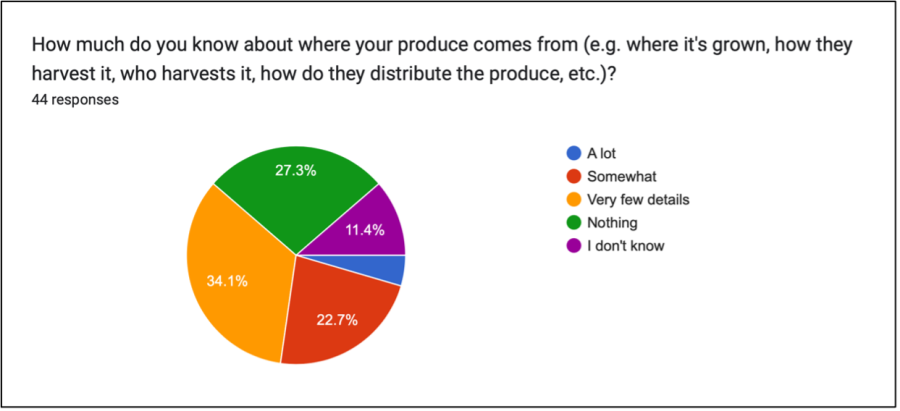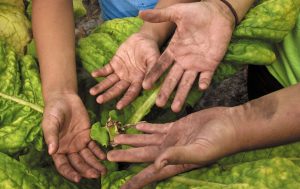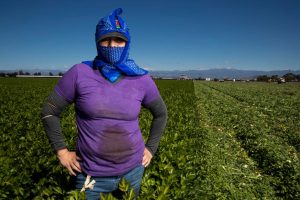4 Who’s Doing the Picking: The Dark Past of Our Produce
Anna Carroll
Everyone has preferences when it comes to produce. Some exclusively shop organic, others prefer locally grown fruits and vegetables, and most of us just go for whatever is the cheapest. However, despite all the consideration we give when it comes to picking our produce, consumers fail to ask themselves the important questions. Besides the little label marked ‘Grown In…’ most of us don’t know anything about our produce. Regardless of how many times we walk up and down those aisles, we are left clueless as to how the produce got there, how it was harvested, and what chemicals and pesticides were used in the growing process. To gather more insight into what regular consumers of produce are aware of when it comes to what they know about how their produce was grown and harvested, I conducted a survey sampling 44 respondents who regularly buy produce from grocery stores. The survey asked a variety of questions regarding what factors influence the produce consumers buy, how much they know about the labor practices of the agriculture industry, and whether learning about worker abuse and exploitation in the agriculture industry would affect their buying habits. According to the survey question asking, “How much do you know about where your produce comes from (e.g. where it’s grown, how they harvest it, who harvests it, how do they distribute the produce, etc.)?”, the majority of respondents (34.1%) answered “very few details”, followed by 27.3% responding with “nothing”. 22.7% of respondents stated “somewhat”, 11.4% answered “I don’t know”, and a very small portion answered, “a lot”.

If consumers don’t think to ask themselves the basic questions regarding where the produce came from, then how can we expect them to ask about the labor practices of the agriculture industry? If we trace our produce back to its origins, some of us will find that it has a dark past. The agriculture industry is a hotbed for abuse and exploitation where the employers responsible for those crimes face little repercussions for those cruelties. The mistreatment of agriculture workers, specifically migrant workers, is fostered by an overall deficiency in regulatory agencies, protections for foreign labor, and consumer awareness.
To examine the practices in place that promote the mistreatment of agriculture workers, we must first look into the nature of the exploitation of farm workers, one such way being wage theft. Wage theft occurs when workers are not compensated fairly for the hours they work (Costa, Martin, & Rutledge n.d.). In 2019, “investigators found that agricultural employers owed farm workers a total of $6.0 million in back wages and assessed violating employers $6.3 million in civil money penalties” (Costa, Martin, & Rutledge n.d.). When workers are not fairly compensated, it affects all aspects of their lives as they don’t have enough money to properly care for themselves or their families. From there on, workers have to spend more hours doing back-breaking labor to earn the amount of money they should have received from doing earlier work. Wage theft is just one way that the agriculture industry mistreats its workers in an attempt to cut labor costs. As we’ll investigate later, wage theft is only one example of the exploitative practices implemented within the agriculture industry.

Injuries and health concerns that arise through a lack of proper safety precautions and hazardous materials are also some of the most prevalent issues that farm workers face in their day-to-day work. Because of the nature of the labor, agriculture workers are at a higher risk of facing health issues and injuries as a result of the hazardous materials they work around. For example, one common health concern that afflicts many farm workers who work in the tobacco industry is green tobacco sickness. Green tobacco sickness is “a type of nicotine poisoning that happens when workers come in contact with wet tobacco leaves, and they absorb large amounts of tobacco through their skin” (NFWM 2023). Given the proper tools and clothing to work with this crop for hours at a time, this type of sickness could be avoided, however, employers will find ways to cut costs in whatever way they can, even at the expense of their worker’s health.
Sickness and other ill-health effects are not only prevalent in the tobacco industry but is an issue all farm workers encounter when exposed to hazardous chemicals through pesticides. In one study conducted by Wellesley College investigating the impact that pesticides can have on pregnant women, pesticide exposure was linked to infertility, miscarriages, and even birth defects in babies (NFWM 2023). The research done at Wellesley only highlights a few of the devastating effects that pesticides can have on the human body. Farm workers who labor in this type of environment risk long-term exposure to these damaging chemicals which can have harmful effects on their health. Once again, a lack of intervention and prevention procedures on the part of the employer results in hazardous consequences for their workers.

The research focused on women working in the agriculture industry extends beyond health concerns presented by Wellesley College. Sexual assault and harassment are some of the biggest issues that women farm workers face in their day-to-day lives (NFWM 2023). Human Rights Watch reported that nearly all participating women farmworkers said they had experienced sexual violence or harassment, but fear of being reported to immigration authorities can make women hesitant to report violations of their rights (Meng 2023). In addition to the dangers that come from working around hazardous material, women undergo the struggle of working in an unsafe environment where there are very few consequences for those that commit sexual assault and harassment. Many of these women are immigrants who don’t have the proper work authorizations to work in the United States, and therefore, have little support and resources when it comes to reporting crimes like sexual assault and harassment. The lack of consequences violators face further promotes the hostile conditions in which women are forced to work. Until safer conditions are offered for women, in conjunction with a proactive plan that prioritizes women’s safety with zero tolerance for violating that safety, the agriculture industry will be a breeding ground for worker abuse and mistreatment.
One of the factors that is in part responsible for the worker mistreatment outlined above (e.g. wage theft, exposure to harmful chemicals, and sexual assault and harassment) is the lack of protection for foreign workers. Many of the agriculture workers who are at risk of being exploited by their employers are foreign workers who did not receive work authorization or hold a temporary work authorization. Because of the precariousness of the US work authorization, the protections offered to migrants by the United States government are extremely limited. It also puts the employers in a position of power—more so than usual—as they knowingly hire workers who have very few options when it comes to places of employment. Taking advantage of migrants needing to work, employers offer terrible conditions with little pay knowing the workers would not have better alternatives available to them. For US citizens employed in the country, there are a series of laws and regulations in place to protect them from being exploited by their employers. These laws and regulations help balance out the power discrepancies between the employer and the employee. However, for those who are non-citizens of the United States, the reach of those laws and regulations falls short, often resulting in employers exploiting their foreign workers with very few consequences. Due to the lack of resources available to undocumented workers and for fear of being deported, migrant workers don’t have anyone to turn to offer the legal help that would hold the employers accountable for the exploitation.
Foreign workers face exploitation through legitimate government programs as well. The H2-A program is a federal guest worker program offering temporary status to agricultural workers for 10 months or less (NFWM 2023). In theory, this program seems a good method to account for the lack of labor during important times during the growing season, however, the way this program is structured and the lack of protections provided to employees in this program have created a whole host of problems for the foreign workers the program is said to be designed to help. Due to the stipulation that the invitation to work next season is required to come through the employer who hired them, foreign workers are too often afraid to report any abuses they experience at the hands of the employer that is providing their work visa (NFWM 2023). “The dependency that workers have on their employers creates an imbalance of power which leaves migrant workers vulnerable to the demands of their employers.” The dependency that workers have on their employers creates an imbalance of power which leaves migrant workers vulnerable to the demands of their employers. Many employers and labor contractors actively seek H2-A workers for this reason, as they can get away with more abuses and wage theft without any consequences. To correct and prevent the exploitation that arises through programs like H2-A, the system has to undergo various changes regarding the way it structures the program, from recruiting processes to measures that ensure the fair treatment of foreign workers.
Lack of funding for federal departments like the Wage and Hour Division (WHD), which enforces federal labor laws, also contributes to the exploitation and abuse of foreign workers. Each year, the number of investigations the WHD conducts declines, allowing even more worker rights violations to occur without any consequences for the violators. For example, the WHD investigations in the agriculture sector fell from 2,431 in 2000 to 1,125 in 2019 (Costa, Martin, & Rutledge n.d.). That means the number of investigations in recent years is half of what it was two decades ago. According to the Economic Policy Institute, the decline in funding for this department is thought to be largely responsible for the lack of investigators and investigations happening in the country (Costa, Martin, & Rutledge n.d.). Without the proper funds to pay investigators and keep the department running, the number of investigations inquiring into the treatment of farm workers will continue to decline, further allowing more of these gross violations to occur without any fear of consequences on the employers’ part.
The last factor contributing to agricultural worker exploitation that we will be examining is the lack of awareness that consumers have about the agriculture industry and the conditions under which the employees suffer. Through my own experience going to the produce section of the grocery store, I am constantly confronted with labels: ‘Fresh’, ‘Organic’, and ‘Locally grown’. Yet, these labels scarcely tell us anything about where this produce came from, let alone who picked it. From the survey sample, around 61% claimed that they knew little to no details regarding where their produce comes from, showing that a lot of consumers are left in the dark regarding the process of how their food gets in stores, including who harvested it. Survey data suggests that if consumers were a little more enlightened on what really goes on in the fields, this would go on to influence their purchasing habits.
When asking consumers whether learning a vendor had mistreated their farm workers (whether that be wage theft, lack of protections, or sexual harassment and assault) would influence their future purchasing from that “If consumers start selectively buying their produce from vendors that ensure fair labor practices it will go a long way in encouraging other vendors to cultivate a just, safe working environment for their employees.” vendor, the majority of respondents stated that it would either “very likely” (43.2%) or “somewhat likely” (27.3%) influence those purchasing decisions. If consumers start selectively buying their produce from vendors who ensure fair labor practices it will go a long way in encouraging other vendors to cultivate a just, safe working environment for their employees. Due to the lack of funding and protections that are offered to agriculture workers, especially foreign workers, there is little to stop employers from exploiting their workers. Until protections are provided, it is up to the consumers to demand better treatment for the people who help us put food on the table.
The current practices that exploit agriculture workers are allowed to continue by the contributing forces of a lack of protections for foreign laborers, a decline in funding for enforcement agencies, and a lack of consumer awareness. The agriculture industry requires drastic systematic changes to address the human rights abuses that occur so frequently. To cut operational and labor costs, agriculture employers find ways to exploit their workers for low-cost—and sometimes free—labor. In the United States, consumers have rallied around the cause of protesting the abuse that occurs in sweatshops and have boycotted products on the basis that companies wouldn’t let their workers unionize, demonstrating that the issue doesn’t revolve around consumers’ apathy towards workers’ rights. The issue at hand is that consumers aren’t aware of these abuses in the agriculture industry. So, the next time we go into a grocery store, we owe it to the workers to start asking whether our produce comes from a place that respects its employees.
References
Costa, R. • B. D., Martin, P., & Rutledge, Z. (n.d.). Federal Labor Standards Enforcement in agriculture: Data reveal the biggest violators and raise new questions about how to improve and target efforts to protect farmworkers. Economic Policy Institute. https://www.epi.org/publication/federal-labor-standards-enforcement-in-agriculture-data-reveal-the-biggest-violators-and-raise-new-questions-about-how-to-improve-and-target-efforts-to-protect-farmworkers/
Issues Affecting Farm Workers. NFWM. (2023, January 13). https://nfwm.org/farm-workers/farm-worker-issues/
Meng, G. (2023, March 28). Cultivating fear. Human Rights Watch. https://www.hrw.org/report/2012/05/15/cultivating-fear/vulnerability-immigrant-farmworkers-us-sexual-violence-and
